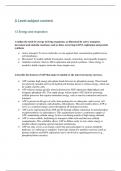Summary
Summary 40k words!!! A2 Biology Syllabus Analysis|2024 Newest!
This A2 CIE Biology syllabus analysis provides a detailed, point-by-point explanation of each syllabus item, directly aligned with the official exam guide. Every topic is broken down into its components, offering students clear and concise interpretations, which makes it an excellent tool for study...
[Show more]



